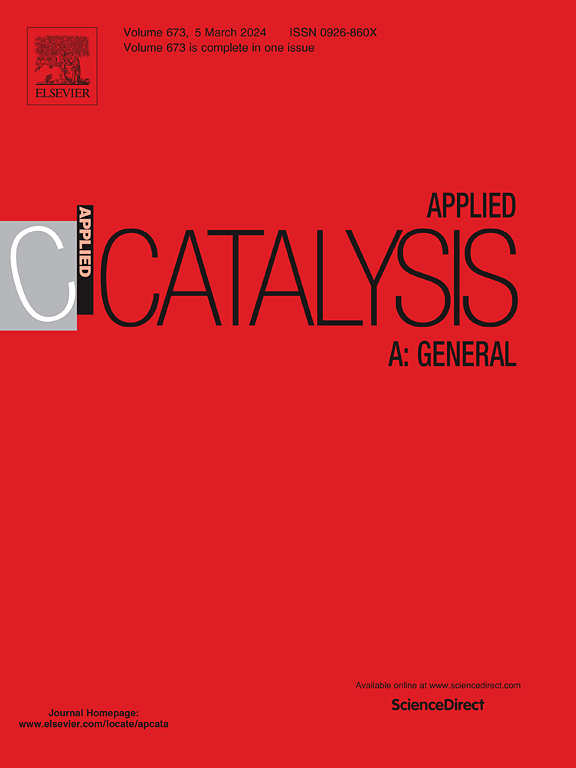低成本FeNi催化剂对双氢丁香酚加氢脱氧制备可再生烷烃燃料的影响
IF 4.7
2区 化学
Q2 CHEMISTRY, PHYSICAL
引用次数: 0
摘要
采用两步浸渍法制备了不同的镍铁催化剂,在300 °C、30 bar的连续反应器中研究了双氢丁香酚的无溶剂加氢脱氧。研究了介孔催化剂FeNi/Al2O3、FeNi/SiO2、FeNi/H-MCM-48以及微孔催化剂FeNi/ h - β -300、FeNi/ h - β -38、FeNi/H-Y-5.1、FeNi/H-MCM-48和FeNi/USY-30。采用SEM、能量色散x射线分析、Mössbauer和x射线吸收光谱、氢TPR、x射线衍射、TEM、氮物理吸附和FTIR吡啶吸附等方法对催化剂进行了表征。通过DFT计算来阐明Fe和Ni的作用。结果表明,FeNi/Al2O3在双氢丁香酚加氢脱氧中最具活性和稳定性。二氢丁香酚完全转化,主要产物丙基环己烷收率在84 ~ 88 %之间。FeNi/Al2O3催化剂具有3.4 nm的金属颗粒,含有fcc金属结构的FeNi合金颗粒。在5 小时的时间内,FeNi/ Al2O3未被观察到失活,这是由于EXAFS证实了富镍颗粒的存在,其外表面富含铁。铁被证明负责脱氧,而镍促进氢化。除FeNi/Al2O3外,在相同的反应条件下,由于其Brønsted与Lewis酸位比更高,平均金属粒径更大,除FeNi/Al2O3外,其他所有催化剂的催化剂失活时间都增加。本文章由计算机程序翻译,如有差异,请以英文原文为准。
Effect of catalyst support on dihydroeugenol hydrodeoxygenation on low cost FeNi catalyst to produce renewable alkane fuel
Solventless hydrodeoxygenation of dihydroeugenol was investigated in a continuous reactor at 300 °C under 30 bar over different nickel-iron catalysts, prepared using a two-step impregnation method. The following catalysts were studied: mesoporous FeNi/Al2O3, FeNi/SiO2 and FeNi/H-MCM-48 as well as microporous FeNi/H-Beta-300, FeNi/H-Beta-38, FeNi/H-Y-5.1, FeNi/H-MCM-48 and FeNi/USY-30. The catalysts were characterized by SEM coupled with energy dispersive X-ray analysis, Mössbauer and X-ray absorption spectroscopy, hydrogen TPR, X-ray diffraction, TEM, nitrogen physisorption and FTIR pyridine adsorption. DFT calculations were performed to elucidate the role of Fe and Ni. The results revealed that FeNi/Al2O3 was the most active and stable in dihydroeugenol hydrodeoxygenation. Complete conversion of dihydroeugenol was obtained and the yield of the main product propylcyclohexane was varying in the range 84–88 %. FeNi/Al2O3 catalyst exhibited 3.4 nm metal particles and contained FeNi alloy particles with the fcc metallic structure. No deactivation was observed for FeNi/ Al2O3 during 5 hours time-on-stream due to the presence of Ni-rich particles with iron-enriched outer surface confirmed by EXAFS. Fe was shown to be responsible for deoxygenation, while Ni promotes hydrogenation. Catalyst deactivation was observed for all other catalysts except for FeNi/Al2O3 with increasing time-on-stream under the same reaction conditions due to their higher Brønsted to Lewis acid site ratio and larger average metal particle size in comparison to FeNi/Al2O3.
求助全文
通过发布文献求助,成功后即可免费获取论文全文。
去求助
来源期刊

Applied Catalysis A: General
化学-环境科学
CiteScore
9.00
自引率
5.50%
发文量
415
审稿时长
24 days
期刊介绍:
Applied Catalysis A: General publishes original papers on all aspects of catalysis of basic and practical interest to chemical scientists in both industrial and academic fields, with an emphasis onnew understanding of catalysts and catalytic reactions, new catalytic materials, new techniques, and new processes, especially those that have potential practical implications.
Papers that report results of a thorough study or optimization of systems or processes that are well understood, widely studied, or minor variations of known ones are discouraged. Authors should include statements in a separate section "Justification for Publication" of how the manuscript fits the scope of the journal in the cover letter to the editors. Submissions without such justification will be rejected without review.
 求助内容:
求助内容: 应助结果提醒方式:
应助结果提醒方式:


